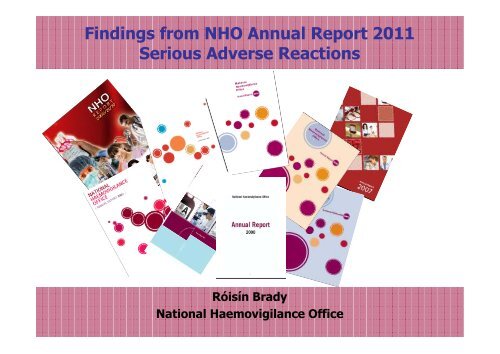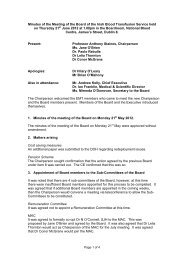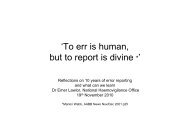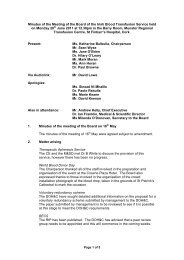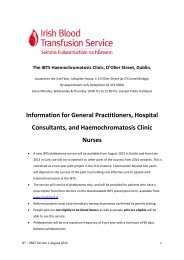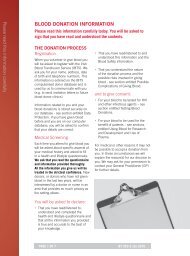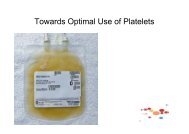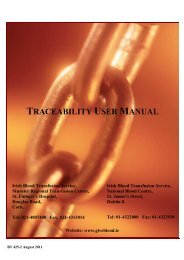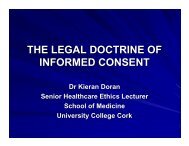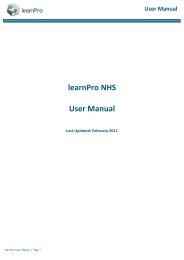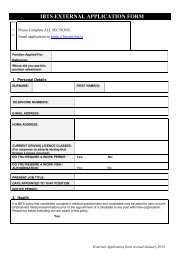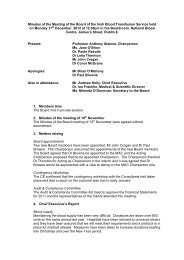Findings from NHO Annual Report 2011 Serious Adverse Reactions
Findings from NHO Annual Report 2011 Serious Adverse Reactions
Findings from NHO Annual Report 2011 Serious Adverse Reactions
You also want an ePaper? Increase the reach of your titles
YUMPU automatically turns print PDFs into web optimized ePapers that Google loves.
<strong>Findings</strong> <strong>from</strong> <strong>NHO</strong> <strong>Annual</strong> <strong>Report</strong> <strong>2011</strong><strong>Serious</strong> <strong>Adverse</strong> <strong>Reactions</strong>Róisín BradyNational Haemovigilance Office
<strong>Serious</strong> <strong>Adverse</strong> <strong>Reactions</strong> <strong>2011</strong>(SAR)- Main findings155 SAR reports submitted <strong>from</strong> 40 hospitals130 SAR reports accepted ↓ 2010 Figures16 reports involved paediatric patientsNo reports: Acute haemolytic transfusion reaction Suspected transfusion transmitted infection (viral or bacterial) Transfusion Associated Graft versus Host Disease (TAvGHD), Post Transfusion Purpura (PTP) <strong>Adverse</strong> donor reactions related to predeposit autologous transfusion(PAD). TRALIPoints to Note: 9 reactions occurred as a result of an error – 2 occurring inpaediatric patients26/11/2012 National Haemovigilance Office 2
<strong>Serious</strong> <strong>Adverse</strong> Reaction <strong>Report</strong>s accepted by the <strong>NHO</strong>20092010<strong>2011</strong>Acute TransfusionreactionsImmunological haemolysis due to ABOIncompatibility020Immunological haemolysis due to other alloantibody(Acute < 24 hrs)240Acute Allergic and AnaphylacticTransfusion <strong>Reactions</strong>285159Febrile Non Haemolytic TransfusionReaction374631Unclassified SAR342Hypotensive Transfusion Reaction120Delayed HaemolyticTransfusion <strong>Reactions</strong>Immunological haemolysis due to other alloantibody(Delayed > 24 hrs)14116RespiratoryComplications oftransfusionTransfusion Associated Circulatory Overload(TACO)182432Transfusion Associated Dyspnoea320Transfusion related acute lung injury(TRALI)000Suspected TransfusionTransmitted InfectionTransfusion transmitted bacterial infection130Transfusion transmitted viral infection320Totals110151130
Acute Allergic and AnaphylacticTransfusion <strong>Reactions</strong> (n=59)<strong>Findings</strong> 59 <strong>Report</strong>sPatients Infant (1-4 years) - 1 Child (5-11 years) - 10 Adolescent (12-17 years) - 3 Adult (18-30 years) -4 Adult (31-50 years) - 8 Adult (51 - 70 years) - 17 Elderly (70+) – 16Implicated components Apheresis Platelets –34 Red Cells -17 Pooled Platelets -8Investigations IgA levels – 23No cases of IgA deficiencyFrequently investigations don’t finda cause – alternative causes such asdrug/food/latex allergy should beconsideredClinical Outcome Complete Recovery - 57 Minor Sequelae - 2ISBT Categorisation Grade 1 - Minor (mucocutaneoussymptoms) - 13Grade 2 - severe (respiratory/cardiacinvolvement) - 44 Grade 3 - life threatening - 226/11/2012 National Haemovigilance Office 4
Acute Allergic and AnaphylacticTransfusion <strong>Reactions</strong> - Case 1Background:A group O Rh D positiveadolescent with anunderlying complexhaematological conditionwas transfused with a unit ofgroup O Rh positiveapheresis platelets prior tothe removal of a portacath.Platelet count was 77x10 9 /LApproximately 180mls of theplatelet had transfusedSymptoms:Temperature riseHypertensionTachycardiaDyspnoeaCyanosisStridor WheezeFalling O 2 SatsRestlessness and anxiety26/11/2012 National Haemovigilance Office 5
Acute Allergic and AnaphylacticTransfusion <strong>Reactions</strong> - Case 1InvestigationsIgA levelBacterial investigations ofpatient and packSerological investigationsClinical OutcomeThe patient made completerecoveryOn review by haematologyteam – transfusion notrequired prior to theprocedureCause of errorHuman failure – knowledge26/11/2012 National Haemovigilance Office 6
RecommendationsFuture transfusion requirements – 40 cases indicated pre med coverhowever new BCSH recommendation indicatesBCSH - Recommendation For recurrent mild allergic reactions, there is no evidence to support routineprophylaxis with antihistamines or steroids. Alternative causes such as allergy todrugs or latex gloves should be excluded. (2C)RecommendationFor patients with recurrent moderate or severe allergic reactions, other than thosein which the patient is IgA deficient, options for further transfusion include:Use of directly monitored transfusion of standard components in a clinical areawith resuscitation facilities.Consider antihistamine prophylaxis (although the evidence for efficacy is low, therisks are also low).26/11/2012 National Haemovigilance Office 7
Interactive Case 1Following investigations werecarried out.Re group X match and antibodyscreen – negativeDAT – negativeLiver function tests/Bilirubinlevel – within normal rangeBacterial Screening of patient–no growth observed after 5daysBacterial screening of pack andadministration set – positive forcomensalsSegment line – negative culture.Of note the pack had remained inthe clinical area for 12hrs priorto return to the blood bank.TreatmentPatient was commenced onantibiotics.BE contacted – pack returned toNBC for culturingPack, administration set andsegment line – negative cultures26/11/2012 National Haemovigilance Office 9
Case 1 QuestionHow would you now classify this reaction ?1. Febrile Non haemolytic transfusion reaction2. Suspected transfusion transmitted infection– bacterial3. Not transfusion related – symptoms due tounderlying condition26/11/2012 National Haemovigilance Office 10
Case 1Captured as a Febrile Non Haemolytic TransfusionReaction Imputability likely/probable Patient made a complete recovery.26/11/2012 National Haemovigilance Office 11
Febrile Non-Haemolytic Transfusion<strong>Reactions</strong>(FNHTR) (n=31)<strong>Findings</strong>31 reports received 2010 figuresPatients: Infant (1-4 years) -1 Adolescent (12-17 years) -1 Adult (18-30 years) -3 Adult (31-50 years) - 7 Adult (51 -70 years) – 8 Elderly (70+) -11Components Implicated26 - red cells3 - apheresis platelets2 - pooled plateletsInvestigationsmajority of the cases were investigated forbacterial contamination : 25 (81%) patients had blood cultures taken,20 (65%) cases the pack cultured18 (58%) cases both the patient and packwere cultured.18 (58%) repeat serologicalinvestigations10 cases reported - Basic checking ofpatient and unit -10 (32%) cases - serological andbacterial investigations of bothpack and patientClinical OutcomeAll patients made a complete recovery26/11/2012 National Haemovigilance Office 12
RecommendationClerical check: recheck the identity of the patient and theimplicated units<strong>NHO</strong> recommendations on investigationsAs a minimum blood cultures and investigations for haemolysis shouldbe taken on patients suffering a FNHTR to exclude red cellincompatibility or bacterial contamination.BCSH 2012 RecommendationFor patients with recurrent febrile reactions, recommend a trial ofpremedication with oral paracetamol given one hour before thereaction is anticipated (or nonsteroidal anti-inflammatory drugs inpatients with predominant chills or rigors - but an assessment of therisks of medication against the severity of reaction should be made ineach case).26/11/2012 National Haemovigilance Office 13
Immunological haemolysis due toother allo-antibody (Delayed>24hrs) n=6<strong>Findings</strong>6 reportsPatients Elderly > 70 years – 3 Adult 51-70 years – 3Imputability Likely/Probable -3 Possible - 3Previous Transfusion HistoryUnknown in 2 case if previouslytransfusedPrevious transfusion in 4 casesInvestigations New antibodies identified anti c,anti E, anti Fy b, anti Jk a, anti Jk b,anti SCategory Group 2(+DAT,Fall in Hb) - 6<strong>Reactions</strong> occurring as a result oferrors - 326/11/2012 National Haemovigilance Office 14
DHTR – Case 1An elderly patient was admitted with a GIbleed and symptomatic anaemia Hb7.0g.dl.A sample was referred to the referencelaboratory anti c, anti Jka and anti Swere identifiedPretransfusion antibody screen wasnegative Transfused with 8 units of redcells over a four day period.Hb failed to rise.Unclear whether this was due to ongoingbleed or haemolysis.On investigation the patient had anelevated bilirubin levelRepeat group and antibody screen waspositive for anti c and an unidentifiedantibody.On further investigation in the HBB aprevious antibody card labelled with thepatients name was identified indicationthe patient had a previous anti c and antiJka, however as the patient identifierswere incomplete it could not beconfirmed as the same patient.On further discussion with the patient sheidentified that during her pregnancies shehad been advised of her antibodiesDAT was also positive26/11/2012 National Haemovigilance Office 15
Interactive - Case 2Background:Young man admitted with exacerbation of underlying GI conditiontransfused late at night with 1 unit of RCC for anaemia.Weight 93.1kgsFluid balance – +1300 mls 12 hrs pre transfusion.At the time the transfusion is commenced the patient also has IVNaCl 1 Litre infusing concurrently. Patient had been spikingtemperatures pre transfusion but was not currently onantibiotics.Baseline obs T 36.6, P 98, BP 101/62 O 2 sats 100% on room air26/11/2012 National Haemovigilance Office 16
Interactive -Case 2Just over 1 hour into transfusion patient developed Pulse 200, BP 115/65, O 2 88%Treatment Commenced on oxygen 2 litres via nasal prongs , IV furosemide40mgs given stat. 2 hrs later c/o headache, pyrexia 39.3, P 125, BP 95/65Treatment Panadol administered, commenced on 2nd litre NaCl and colloidcommenced stat Oxygen is continued and Saline nebs also commenced.26/11/2012 National Haemovigilance Office 17
Interactive -Case 2Following investigations were carried out.Re group X match and antibody screen – negativeDAT – negativeLiver function tests/Bilirubin level – within normalrangeBacterial Screening of patient and pack – no growthobserved after 5 daysCXR,ABG26/11/2012 National Haemovigilance Office 18
Interactive - Case 2CXR showed – Widespread opacification inboth lungs – differential included pulmonaryodema perhaps due to fluid overload orinfection.TreatmentIV fluids discontinuedFurther dose of IV furosemide 40mgs stat26/11/2012 National Haemovigilance Office 19
Interactive - Case 2How would you classify this reaction ?1. Febrile non haemolytic transfusion reaction2. Anaphylaxis/Hypersensitivity3. Transfusion associated circulatory overload4. Not transfusion related – due to underlyingcondition26/11/2012 National Haemovigilance Office 20
Interactive - Case 2Captured as a TACO Imputability possible . Patient made a complete recovery.26/11/2012 National Haemovigilance Office 21
Transfusion Associated CirculatoryOverload<strong>Findings</strong> 32 (25%) reports fulfilled thecriteria for TACO – 4 reactions as a result of errors – allhuman error – knowledge, slipsPatients21 elderly (>70 years)7 adults (51-70 years)2 adults (31-50 years)2 adult (18-30 years)Implicated Components 29 RCC 1 SD Plasma Only 2 cases involved multiplecomponents 19 patients had received anothercomponent in previous 24 hours Occurred in six cases where thevolume transfused was between 50-100mls.Most frequently occurring symptoms Dyspnoea (30 cases) Falling O 2Sats (17cases) Hypertension (14 cases)Stridor/Wheeze (14 cases)Restlessness/anxiety (10 cases)Underlying conditions Cardiac - 17 Respiratory – 17 Renal – 6 12 patients had more than oneunderlying condition. 2 patient had all three underlyingconditions 6 patients had no pre-existing conditions.26/11/2012 National Haemovigilance Office 22
TACO–And the fluid balance !Careful estimation of the patient’s hydration and cardiac statusprior to the transfusion. Thorough review of the patient’s fluidbalance during the transfusion. (<strong>NHO</strong> 2008)For patients identified at risk of TACO, a written request should bemade that during the administration of blood components,specific attention should be given to monitoring the patient forsigns of circulatory overload, including fluid balance. (BCSH2012)<strong>NHO</strong> <strong>Findings</strong>Only 10 patients had completed fluid balance19 patients had received another component in previous 24 hrs.Only 6 of these patients had a complete fluid balance.26/11/2012 National Haemovigilance Office 23
TACO – <strong>Reactions</strong> occurring as a result ofan error (n=4)Case history 1BackgroundA middle aged female patient transfused with2 units of RCC. Underlying respiratorycondition. Patients Hb was 10.8g/dl but shewas complaining of fatigue and previoustransfusions had been of benefit.Each unit was prescribed over 4 hoursHer weight was between 50-59kgsNo fluid balance despite receiving twounits of RCC.SymptomsAt the end of the second unithypertension,dyspnoea, falling O2 sats 83%InvestigationsChest x-ray showed - pulmonaryodemaTreatmentIV furosemide 80mgsOxygen therapyNebulisersThe patient made a complete recoveryOn review – the patient Hb was14.7g/dl post transfusion suggestingthat the second unit wasinappropriate and it was alsoidentified that the transfusion wasnot prescribed on a unit by unitbasis26/11/2012 National Haemovigilance Office 24
TACORecommendations<strong>NHO</strong> RecommendationTransfusion should be on a unit by unit basis, with a medicalassessment of the patient prior to commencing transfusion andbefore administering any further component.BCSH 2012 Recommendation Clinical assessment should include an evaluation of the patient’sage, body weight and concomitant medical conditions thatpredispose to TACO.26/11/2012 National Haemovigilance Office 25
TACO recommendationsBCSH Guideline on the Administration of BloodComponents Addendum August 2012These factors should be documented in thepatients’ clinical notes and should be consideredwhen prescribing the volume and rate of thetransfusion, and in deciding whether diureticsshould be prescribed.The rate of transfusion should be carefullyassessed, as TACO can occur after only one unit ofred cells in at risk patients26/11/2012 National Haemovigilance Office 26
http://www.cartoonstock.com/newscartoons/cartoonists/dhn/lowres/dhnn43l.jpg


